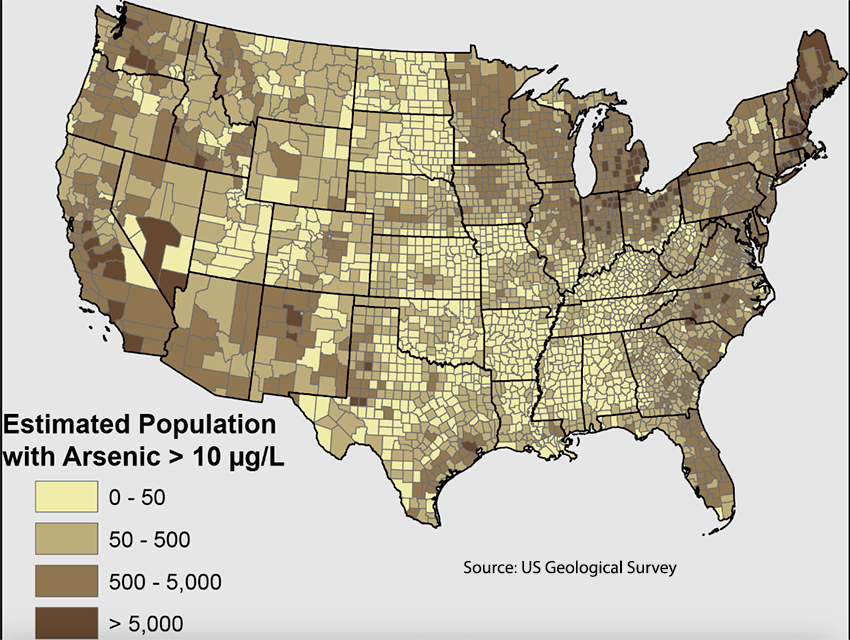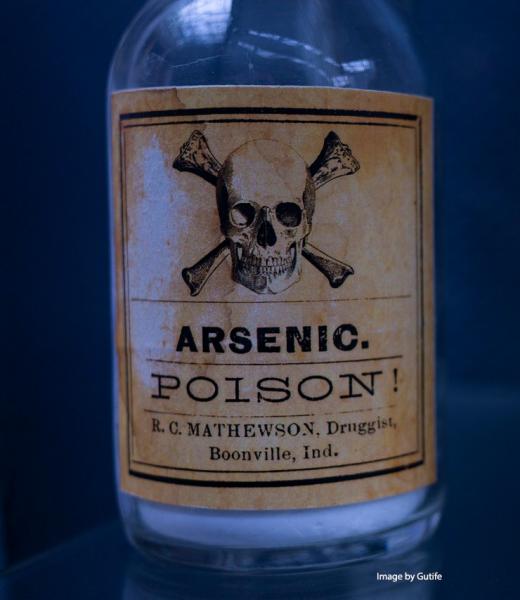Arsenic, the chemical element (As) thirty-three in the periodic table, combines with oxygen, chlorine, and sulfur in the environment to form inorganic arsenic compounds. These compounds may be present as solid minerals or dissolved in water. Inorganic arsenic is the most toxic form of arsenic, with arsenic trioxide being the most common form. Arsenic also combines with carbon and hydrogen to form less toxic organic arsenic compounds often found in fish and shellfish.
Both Poisonous and the Magic Bullet
Arsenic has been used throughout history as the perfect poison; Nero used it to poison his stepbrother in 55 C.E., enabling him to become the Emperor of Rome. It is odorless and tasteless and was virtually undetectable in food or drink until the 19th Century when the first tests were developed. Interestingly, arsenic is also useful therapeutically. In 1909, Paul Ehrlich discovered that arsenic was an effective treatment for syphilis. Compound 606, known as “the arsenic that saved lives,” or Salvarsan – a combination of arsenic with bismuth or mercury, became the primary treatment for syphilis until the discovery of penicillin in 1943. Ehrlich coined two terms for his discovery: the “magic bullet” against syphilis and a term that comes down to us today: chemotherapy. Arsenic trioxide was approved by the FDA in 2000 for treating relapsed acute promyelocytic leukemia (AML), and research continues today on its use to treat other blood cancers.
Where is Arsenic Found?
Arsenic is present in the earth’s crust at 2-5 parts per million (ppm). It is found naturally in rocks and soil and dissolves in groundwater and surface water, such as lakes and rivers, where fish and other organisms take it up. Arsenic particles enter the air and can travel long distances, settling back to the soil where plants and animals take them up and enter the food chain.
Typically, air contains very low levels of arsenic, except for regions with volcanic activity (think Iceland, where volcanoes release large amounts of arsenic). Burning fuels that contain arsenic, such as coal, released high levels of arsenic into the air in the past, but modern control technology has greatly reduced arsenic levels.
Water
 Groundwater (wells) usually contain higher levels of arsenic than surface water (lakes, rivers, and streams). Levels of arsenic above the EPA’s maximum contaminant level (MCL) of 10 parts per billion (ppb) have been found in private drinking water wells in 25 states, about 2.1 million people, as shown on the map.
Groundwater (wells) usually contain higher levels of arsenic than surface water (lakes, rivers, and streams). Levels of arsenic above the EPA’s maximum contaminant level (MCL) of 10 parts per billion (ppb) have been found in private drinking water wells in 25 states, about 2.1 million people, as shown on the map.
Public water systems are required by law to test to ensure that the arsenic levels do not exceed EPA’s MCL of 10 ppb. [1] The EPA’s MCL does not apply to private drinking water wells.
Food
Arsenic enters food primarily from the soil. Levels of arsenic in food range from about 20 to 140 parts per billion (ppb), levels not of concern. The primary source of dietary arsenic is seafood, followed by rice, mushrooms, and poultry. Although seafood contains the greatest amount of arsenic, most of it is in the less toxic organic form.
Rice contains more toxic inorganic arsenic levels than other crops because it is grown in flooded fields and is very porous. White rice, where the outer hull has been removed, usually contains less arsenic than brown rice. However, unless you eat huge amounts of rice daily, this should not affect your health. [2] However, it is recommended that babies and infants avoid rice products, e.g., rice cereal.
Other Sources
If you are looking for another reason to stop smoking, cigarette smoke contains arsenic (along with about 4,000 other chemicals). In addition, there have been incidences of
- arsenic contamination of unregulated herbal and nutritional supplements, particularly those manufactured outside the U.S.
- marijuana contaminated by arsenic, including recently in Oregon, where legal marijuana was recalled for testing positive for arsenic
Arsenic Globally
Arsenic exposure is a significant problem globally. High levels of arsenic (ranging from approximately 100 ppb to 300 ppb) were first identified in 1992 in wells in Bangladesh, with 50 million people determined to be at risk for health effects from drinking water from these wells. In 2012, there were 65,910 cases of arsenicosis, a dermatological condition consisting of skin lesions and hard patches on the palms and soles of the feet.
“Blackfoot Disease,” a disease characterized by a progressive loss of circulation in the hands and feet, leading ultimately to necrosis and gangrene, was first identified in Taiwan in the 1960s in areas where the average drinking water levels of arsenic ranged from 170 ppb to 800 ppb. Elevated levels of skin cancer were also reported in these areas of Taiwan, and bladder and lung cancer have also been associated with high levels of arsenic. Neither Arsenicosis nor “Blackfoot Disease” are problems in the U.S.
Unlike many poisons, you cannot totally remove arsenic from your surroundings. Whether from water, air, or food, your body will absorb arsenic. But like all chemicals, the concern is for toxic doses, and for arsenic, that means high concentrations. If you are not a king and subject to poisoning by your subjects or own a private well in areas loaded with arsenic, it remains a chemical to be managed and not feared.
[1] If you want to find out the levels of arsenic (or any other regulated chemical) in a public water system, call your water system and ask for a copy of their water quality report, a Consumer Confidence Report. If you have a private well and want to determine its arsenic levels, have your well tested by a state-certified laboratory.
If the level is above EPA’s MCL, consider retesting the well to confirm the result. Then, you may want to consider installing a water filter to lower the arsenic levels.
[2] You can reduce the amount of arsenic in rice by rinsing raw rice (removes about 10% of the arsenic), boiling rice like pasta (6 cups of water for every cup of rice), then discarding the water and again rinsing the rice (removes an additional 40-60% of the arsenic).




